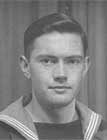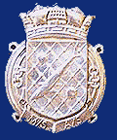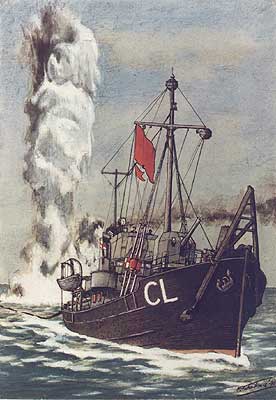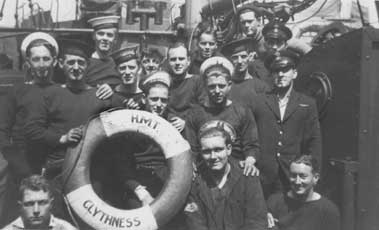


 |
 |
 |
|
A
Scottish Trawler Goes To War I remember well, some 56 years on, that fine autumn evening of wartime 1945. The celebrations of VE day were in the past, and the capitulation of Japan and consequent demobilisation were unknowingly not far off into the future. Further
to a few hours shore leave, I was returning to my armed trawler LOCH
BLAIR, berthed in Aberdeen harbour, when in the failing light I passed
a forlorn looking vessel, deserted and tied up in the inner harbour.
Although her silhouette was strange to me, something about the shape
and rake of her funnel made me stop, and on closer inspection I realised
that this was indeed H. M.Trawler CLYTHNESS, my first ship and the one
which had been the major factor in my life during the hard fought first
three years of the war. Her appearance had certainly changed for the
worse since I had left her at Dover in July, 1943. Squat and ugly fuel
and water tanks had·been added above decks, her wartime paint
was flaking off, and her hull and superstructure were excessively stained
with rust. |
 |
I
knew that CLYTHNESS had been born in this port, long before the outbreak
of WW2, had been named after Clyth, a headland on the Caithness coast,
and for many years had been involved in her peacetime vocation, steaming
over the waters of the North Sea and beyond in search of fish for the
home market. She had been manned by her own hardy fishermen from the
North East, who would have understood the vernacular which so aptly
described her now. She looked "fair forfochan wi' the fray!"
And as I stood there, my thoughts straight back to the adventurous years
we had shared together |
|
(above) HM Trawler Clythness detonating a magnetic mine (painted by the author aboard ship, 1942) Further
to the extremely hazardous dismantling by an R.N. Mine Disposal Unit
of the first German magnetic mine to be examined, found on a sandbank
of the Thames estuary in November, 1939, British scientists eventually
perfected a minesweep which could create a magnetic field, activating
the needle in the mine to explode it. They then invented a "degaussing
girdle" around a ship, a band of wiring around the hull, energised
by an electric current which reversed polarity and neutralised the ship's
magnetism. With this system working efficiently, a vessel could pass
over a mine without exploding it. Prior to these measures being taken,
Hitler had hopes that this type of mine would destroy The British Mercantile
Marine, and it was a fact that Captain Langsdorf of the GRAF SPEE had
informed one of his prisoners, Captain Dove, Master of the S. S. AFRICAN
SHELL that Germany regarded the magnetic mine as the secret weapon which
would be decisive in winning the war. Many ships had been lost around
the British coast, at that time the mines being dropped by parachute
from enemy aircraft into shallow shipping lanes with a paralysing effect.
Each mine rested on the sea bed and contained 6 cwt. of high explosive
which on detonation in shallow water could literally break the back
of a large vessel.. During five days alone in November 1939 fifteen merchant ships
and two destroyers were lost, and two destroyers, the cruiser BELFAST
and battleship NELSON were badly damaged |
 |
Under the command of Lieut. Heckstall-Smith, RNVR, we had steamed out of Hull as strangers to each other and from all walks of life, but with a nucleus of RNR personnel. In a relatively short period of time we had merged into an integrated team, and it was proved to me later in life that it was one of the stranger and perhaps sadder aspects of war, that sharing common hazards and discomforts, along with a justified cause for so doing, engendered a spirit of comradeship and a unified sense of purpose seldom excelled in times of peace. (left) CLYTHNESS crew members, 1940 Ldg. Seaman, Jock Cargill DSM, MM, (dark cap) behind lifebuoy, Frederick J Jenkins top upper right |
Our complement of 23 comprised: 2 officers (1 RNVR, 1 RNR), a Petty Officer Coxswain, 2 Engineman Petty Officers, a Signalman, a Telegraphist, a Gunlayer, a Motorman, a Wireman, 8 Seamen, 3 Stokers, a Cook, a Steward. |
 |
 |